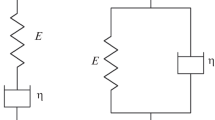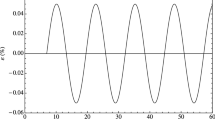Abstract
This paper presents finite element (FE) formulation of the viscoelastic materials described by fractional constitutive law. The time-domain three-dimensional constitutive equation is constructed. The FE equations are set up by equations are solved by numerical integration method. The numerical algorithm developed by the authors for Liouville-Riemann's fractional derivative was adopted to formulate FE procedures and extended to solve the more general case of the hereditary integration. The numerical examples were given to show the correctness and effectiveness of the integration algorithm.
Similar content being viewed by others
References
Koeller RC. Polynomial operators, Stieltjes convolution and fractional calculus in hereditary mechanics.Acta Mechanica, 1986, 58: 251–264
Padovan J. Computational algorithms for FE formulations involving fractional operators.Computational Mechanics, 1987, 2: 271–287
Enelund M, Josefson BL. Time domain FE-analysis of viscoelastic structure having constitutive relations involving fractional derivatives. In: Proceedings of the AIAA/ASME/ASCE/AHS 37th Structures, Structural Dynamics, and Materials Conference, Vol. 2, Salt Lake City, UT, Washington DC: AIAA, 1996. 686–694
Koh CG, Kelly JM. Application of fractional derivatives to seismic analysis of base-isolated models.Earthquake Engineering and Structural Dynamics, 1990, 19: 229–241
Bagley RL, Torvik PJ. On the fractional calculus model of viscoelastic behavior.J Rhed, 1986, 30: 133–155
Makris N. Three-dimensional constitutive viscoelastic laws with fractional order time derivatives.J Rheol, 1997, 41(5): 1007–1020
Papoulia KD, Kelly JM. Visco-hyperelastic model for filled rubbers used in vibration.J of Engineering Materials and Technology, Trans of the ASME, 1997, 119: 292–297
Gurtin ME, Sternberg E. On the linear theory of viscoelasticity.Arch Rational Mech Aual, 1962, 11: 291–356
Miller KS, Ross B. An Introduction to Fractional Calculus and Fractional Differential and Equations. New York: John Wiley & Sons, Inc. 1993. 80–125
Koeller RC. Applications of fractional calculus to the theory of viscoelasticity.Journal of Applied Mechanics, Transactions of the ASME, 1984, 51: 299–307
Zhang W, Shimizu N. Numerical algorithm for dynamic problems involving fractional operators.JSME International Journal, Series C, 1998, 41(3): 364–370
Author information
Authors and Affiliations
Additional information
The project supported by the Ministry of Education of China for the returned overseas Chinese scholars
Rights and permissions
About this article
Cite this article
Wei, Z., Shimizu, N. FE formulation for the viscoelastic body modeled by fractional constitutive law. Acta Mech Sinica 17, 354–365 (2001). https://doi.org/10.1007/BF02487463
Received:
Revised:
Issue Date:
DOI: https://doi.org/10.1007/BF02487463




